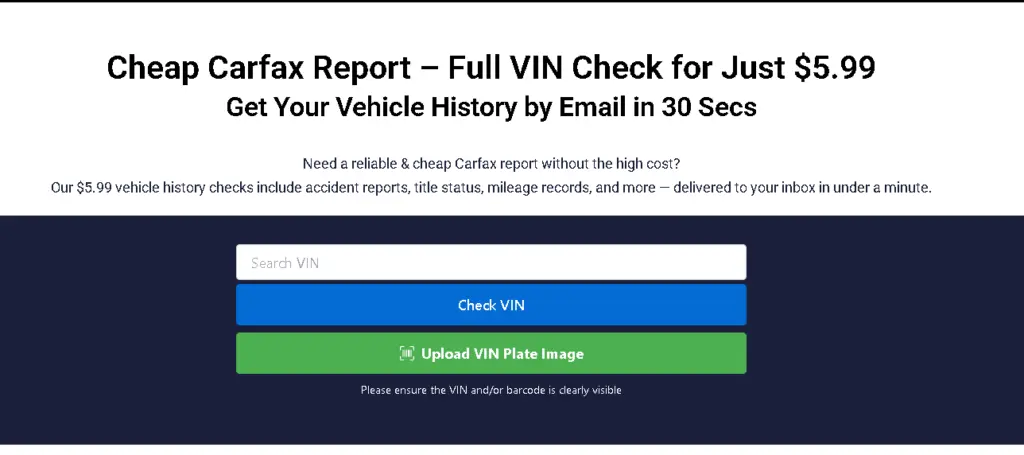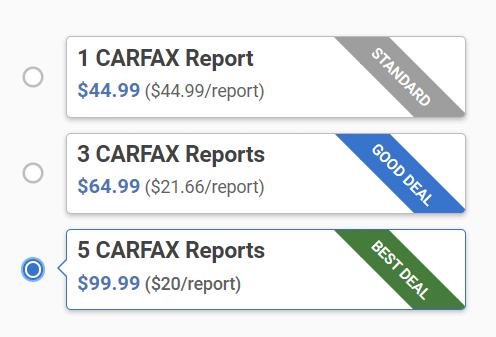A perfect used car isn’t found by luck, but through proper inspection, test drive, and investigation. Over 450,000 used vehicles are sold annually in the United States without appropriate odometers, resulting in buyers losing more than $1 billion due to this fraud each year. We will make sure you are not one of those who don’t know what to look for when buying a used car.
Whether you’re shopping in Los Angeles, Houston, or anywhere across the country, understanding what to look for can help you avoid scams and costly mistakes.
In this guide, backed by first-hand expertise and real-world automotive experience, we’ll walk you through everything you need to know before buying a used car in 2025.
1. Check the Carfax Report of the Used Car
Carfax reports are readily available these days. The vehicle history report provides information on accident history, odometer reading, previous owners, title changes, and any reported damage, including functional damage.
For example, if the report indicates multiple owners within a short period or notes that the car was part of a fleet, it may suggest heavy usage. Watch for inconsistent mileage or title branding, such as “salvage” or “flood damage.” While a clean Carfax doesn’t guarantee the car is problem-free, it significantly reduces the chances of buying a lemon.

Pro Tip: While a clean Carfax doesn’t guarantee a flawless vehicle, it significantly improves your odds of avoiding costly surprises and making a more informed investment.
2. Inspect the Vehicle Interior & Exterior Thoroughly
Check the used car’s interior and exterior carefully. Check the car body thoroughly for any dents, rust spots, water damage, or mismatched paint. These can indicate a vehicle’s past incidents.
Moreover, be sure to request the inspection in daylight, as some sellers may try to conceal car damage. Inspecting the vehicle during the daytime will help you identify issues more easily. Better yet, bring a certified mechanic or someone experienced in evaluating used cars. Most of us aren’t trained to notice subtle signs of prior damage or mechanical issues.
Exterior Checklist
· Thoroughly check the car body from every corner. Inspect any dents around the bumpers, gates, and fenders. Minor dents may be cosmetic, but larger ones could indicate an accident.
· Inspect door bottoms and look for wheel wear. Rust can spread and lead to costly repairs.
· Check the windows and windshield for any types of cracks, chips, or changes.
· Ensure headlights, taillights, brake lights, and turn signals are not cracked and are functioning properly.
Interior Checklist
· Check that the buttons, controls, knobs, and other essentials are working properly. Like the air conditioning, heater, radio, and infotainment system.
· Test the seatbelts of the car. Ensure it functions properly and does not retract.
· An unpleasant odor can make your driving experience horrible. Therefore, pay close attention to any intense or unusual smells inside the car; they can be a sign of hidden problems.
· Lift floor mats to check for moisture or mildew. Inspect the roof lining for signs of sagging or staining.
3. A Test Drive is Compulsory
A test drive is essential when buying a used car. Request a test drive from the seller and drive the car on different types of roads to test its capabilities. This will enable you to assess the vehicle’s condition.
Check the vehicle’s responsiveness, steering performance, and braking stability in different environments. Furthermore, the car shift change should be smooth as well. It shouldn’t have any jerk or hesitation when applied. Rough shift gears, harbinger transmission wear, or low fluid levels. In addition, you can bring someone with prior experience buying used cars or even a mechanic to accompany you on the test drive. A second pair of eyes (and ears) can help you catch subtle issues that you might overlook.
4. Car Window Sticker
The car window sticker serves as a guide for buyers of used cars. It informs you of important details, such as whether the vehicle is being sold “as-is” (meaning you are responsible for any repairs) or with a warranty (meaning some repairs may be covered).
It also lists basic details, such as the car’s make, model, year, and VIN, along with its features and options. The sticker should also include the dealer’s name and contact info, the price, and the mileage. Double-check that everything matches what’s in the Carfax report about window stickers and what the seller told you. This sticker helps you understand what you’re getting and protects you from surprises after the sale.
5. Professional Mechanic Inspection
You might find your desired car perfect for you; however, there may be hidden issues that are not easily noticeable. Therefore, it is essential to hire a professional mechanic for inspection.
The mechanics will inspect the car’s brakes, fluids, oil, engine noise, and undercarriage. The mechanic’s assessment might cost you some money; however, it is worth it, ultimately saving you thousands of dollars in the future.
6. Verify VIN (Vehicle Identification Number)
The VIN is like a car’s fingerprint. Ensure the number on the dashboard matches the one listed on the title, registration, and service records. Still confused? Our free VIN decoder and lockup tool is the game changer. Enter the 17-character VIN of your desired car and receive results in under 5 seconds.
Note: Do not buy cars with tampered VIN plates. It is a strong sign of fraud.
Questions to Ask When Buying a Used Car
Here are some questions to ask the sellers before purchasing the car. If you feel hesitant about the answers and are unsure if the seller is reliable, consider exploring alternative options.
1. Has the Vehicle Encountered Any Accidents?
This is the first question you should ask the seller when making a purchase. Most sellers have the intention of hiding the vehicle’s faults. Even if repairs were made, prior damage might still impact alignment, suspension, or frame integrity.
2. Do you have a Carfax Report?
Even if they don’t have a Carfax report, don’t worry. Use our affordable Carfax tool to generate a report and check any accident history, title change, ownerships, and more. We offer affordable packages for those who wish to purchase in bulk.
3. Was this car used for personal use, commercial purposes, or as a rental/fleet vehicle?
Rental and fleet cars are often driven hard and may have higher wear and tear. Knowing the usage helps you evaluate potential risks and value.
4. Has the car ever been flooded or declared a total loss by an insurance company?
Ask the seller if the vehicle you are buying has ever been flooded or declared a total loss. Flood damage or a salvage title can lead to ongoing electrical issues, rust, or frame problems. Even if the car appears to be in good condition, its history can still affect safety and insurability.
5. Can I see the VIN so I can run my report?
Verifying the VIN allows you to cross-check the car’s identity and pull your vehicle history. It protects you from tampered records or fraudulent listings. You can use our free VIN decoder tool for Carfax.
Conclusion
First-time buyers are always confused about what to look for when buying a used car. Buying a used vehicle nowadays is challenging. In the above article, we have provided top tips for buying a car and suggested questions to ask the seller, enabling you to make an informed buying decision.
FAQS
1. At What Mileage Should I Stop Buying Used Cars?
There’s no hard rule, but as a general guideline, be cautious with used cars that have over 150,000 miles, especially if there’s no service history or signs of poor maintenance. That said, mileage isn’t everything. A well-maintained vehicle with 160,000 miles can often outlast a neglected one with 90,000 miles.
2. What is 20% Rule When Buying a Used a Car?
The 20% rule is a smart budgeting guideline that suggests spending no more than 20% of your monthly take-home pay on all car expenses, including loan payments, insurance, fuel, and maintenance.
If you bring home $3,000 a month, try to keep total car costs under $600. This helps you avoid getting “car poor” and leaves room in your budget for other essential expenses.




